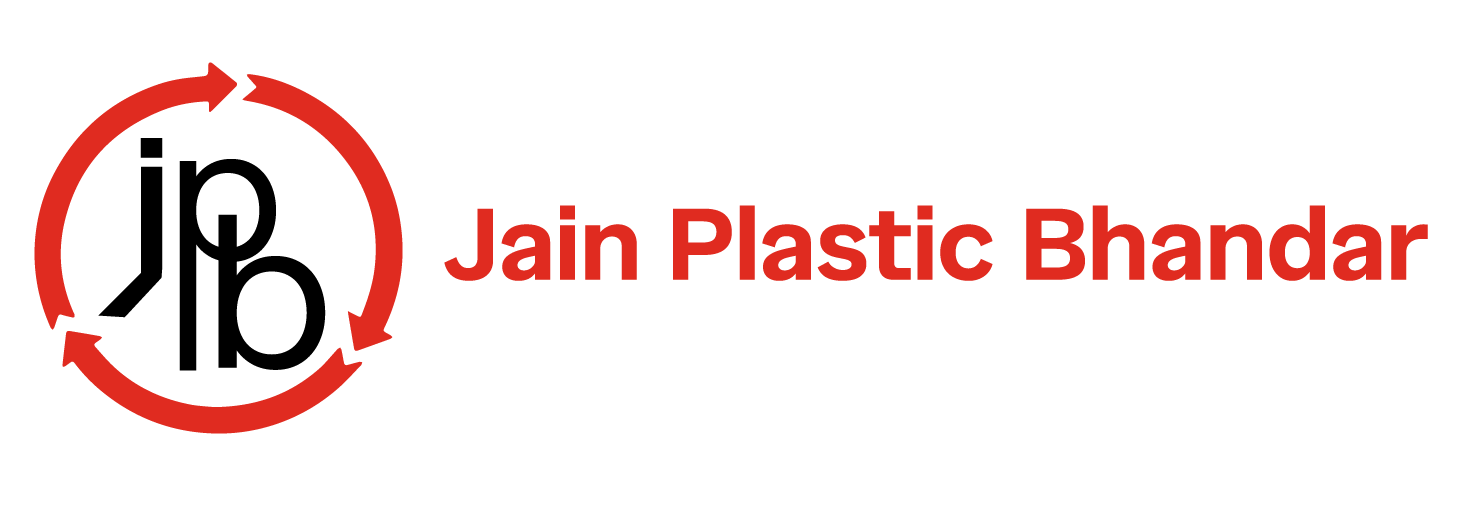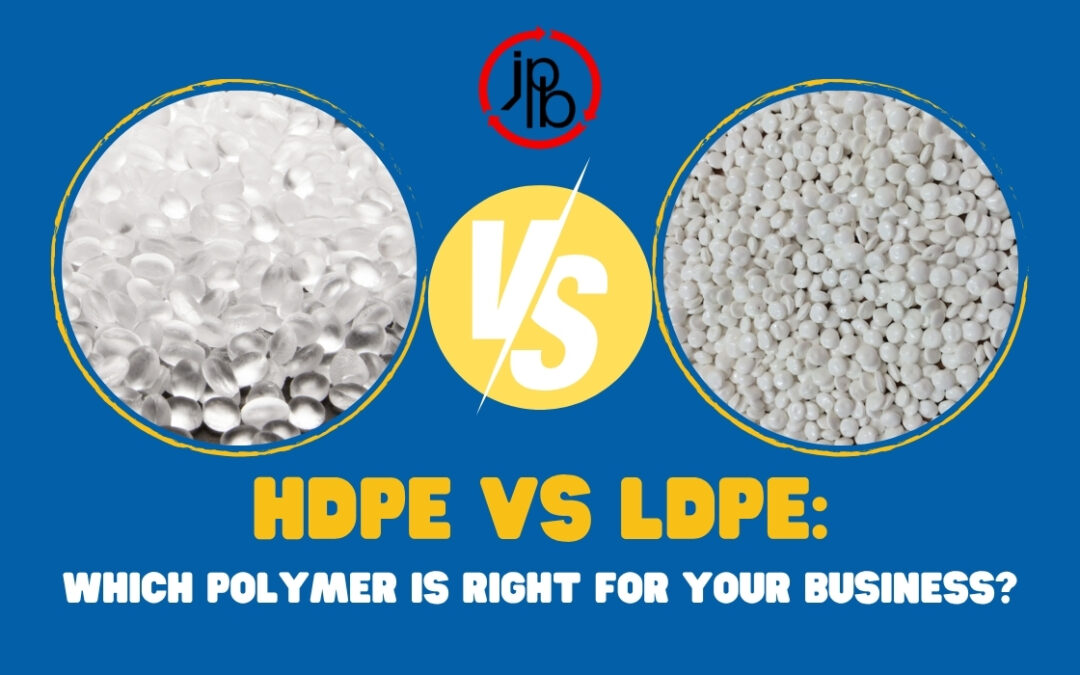HDPE vs LDPE: Which Polymer is Right for Your Business?
In the world of plastics, choosing the right polymer can significantly impact your business’s efficiency, product quality, and profitability. Two of the most commonly used polymers are High-Density Polyethylene (HDPE) and Low-Density Polyethylene (LDPE). Both are versatile, cost-effective, and widely used across industries, but their distinct properties make them suitable for different applications. As the Best Polymer Supplier in Delhi, Jain Plastic Bhandar is committed to helping businesses make informed decisions about their plastic raw material needs. In this comprehensive guide, we’ll explore the differences between HDPE and LDPE, their applications, their advantages, and how to choose the right one for your business.
Understanding HDPE and LDPE: The Basics
Polyethylene (PE) is one of the most widely used plastics globally, valued for its affordability, durability, and versatility. It is derived from ethylene, a hydrocarbon, and can be engineered into various forms, including HDPE and LDPE, by altering its molecular structure during polymerization. The primary difference between HDPE and LDPE lies in their density, which affects their strength, flexibility, and other properties.
- HDPE (High-Density Polyethylene): HDPE is a high-density polymer with a linear molecular structure, resulting in a rigid, strong, and durable material. Its high strength-to-density ratio makes it ideal for applications requiring toughness and resistance to chemicals and environmental stress.
- LDPE (Low-Density Polyethylene): LDPE has a branched molecular structure, which makes it more flexible and less dense than HDPE. It is known for its pliability, transparency, and ease of processing, making it suitable for applications where flexibility is key.
As the Best Plastic Raw Material Supplier in India, Jain Plastic Bhandar offers both HDPE and LDPE in various grades to meet diverse industrial needs. Let’s dive deeper into the properties, applications, and benefits of each polymer to help you determine which is best for your business.
Properties of HDPE
HDPE is characterized by its high strength, rigidity, and resistance to impact and chemicals. Below are its key properties:
- High Strength and Durability: HDPE’s linear molecular structure gives it exceptional tensile strength, making it resistant to impact and capable of withstanding heavy loads.
- Chemical Resistance: HDPE is highly resistant to acids, bases, and solvents, making it ideal for containers that store chemicals or hazardous materials.
- Weather Resistance: HDPE can withstand extreme temperatures, UV radiation, and moisture, making it suitable for outdoor applications.
- Low Moisture Absorption: HDPE does not absorb water, ensuring stability in humid or wet environments.
- Recyclability: HDPE is recyclable, making it an environmentally friendly choice for businesses looking to reduce their ecological footprint.
- High Melting Point: With a melting point of approximately 130–135°C, HDPE can handle higher temperatures than LDPE, making it suitable for applications requiring heat resistance.
These properties make HDPE a preferred choice for industries such as packaging, agriculture, construction, and more. At Jain Plastic Bhandar, the Best Plastic Raw Material Wholesaler in Delhi, we provide high-quality HDPE granules that meet stringent industry standards.
Properties of LDPE
LDPE, in contrast, is known for its flexibility and ease of processing. Its key properties include:
- Flexibility: LDPE’s branched molecular structure makes it highly flexible, allowing it to be stretched and molded into various shapes without breaking.
- Transparency: LDPE is more transparent than HDPE, making it ideal for applications where visibility of the contents is important.
- Ease of Processing: LDPE is easy to mold and extrude, which reduces manufacturing costs and time.
- Chemical Resistance: While not as resistant as HDPE, LDPE still offers good resistance to many chemicals, making it suitable for less aggressive environments.
- Low Melting Point: LDPE has a lower melting point (approximately 105–115°C) than HDPE, which limits its use in high-temperature applications but makes it easier to process.
- Impact Resistance: LDPE is less brittle than HDPE, providing good impact resistance at lower temperatures.
These characteristics make LDPE a go-to material for applications requiring flexibility, such as plastic bags and films. As the Best Polymer Supplier in Delhi, Jain Plastic Bhandar ensures a steady supply of premium LDPE granules tailored to your business needs.
Applications of HDPE
HDPE’s robustness and versatility make it a staple in numerous industries. Some common applications include:
- Packaging: HDPE is widely used for manufacturing bottles, containers, and jugs for products like milk, detergents, and chemicals. Its durability and chemical resistance ensure product safety and longevity.
- Pipes and Fittings: HDPE pipes are used in water supply, gas distribution, and sewage systems due to their corrosion resistance and flexibility.
- Construction: HDPE is used in geomembranes, plastic lumber, and protective liners for landfills and ponds.
- Agriculture: HDPE is used for irrigation pipes, greenhouse films, and mulch films due to its weather resistance and durability.
- Consumer Goods: Items like cutting boards, storage bins, and toys are often made from HDPE due to their strength and safety.
At Jain Plastic Bhandar, we supply HDPE granules that cater to these diverse applications, reinforcing our position as the Best Plastic Raw Material Supplier in India.
Applications of LDPE
LDPE’s flexibility and ease of processing make it ideal for applications where pliability is essential. Common uses include:
- Packaging Films: LDPE is the primary material for plastic bags, shrink films, and stretch films used in food packaging, retail, and industrial applications.
- Squeeze Bottles: LDPE’s flexibility makes it perfect for squeeze bottles used for condiments, cosmetics, and pharmaceuticals.
- Agricultural Films: LDPE is used in greenhouse films, silage bags, and mulch films due to its flexibility and transparency.
- Coatings: LDPE is used as a coating for paper, textiles, and other materials to provide water resistance and flexibility.
- Medical Applications: LDPE is used in flexible tubing and containers for medical supplies due to its safety and ease of sterilization.
As the Best Plastic Raw Material Wholesaler in Delhi, Jain Plastic Bhandar offers LDPE granules that meet the specific requirements of these applications, ensuring high performance and reliability.
Advantages of HDPE for Your Business
Choosing HDPE offers several advantages, particularly for industries requiring robust materials:
- Durability: HDPE’s high strength ensures long-lasting products, reducing replacement costs.
- Versatility: HDPE can be used in a wide range of applications, from pipes to packaging, making it a cost-effective choice.
- Environmental Benefits: HDPE is recyclable and can be reused in various forms, aligning with sustainable business practices.
- Chemical and Weather Resistance: HDPE’s resistance to chemicals and environmental factors makes it ideal for harsh conditions.
- Cost-Effectiveness: While slightly more expensive than LDPE, HDPE’s durability often results in lower lifecycle costs.
Advantages of LDPE for Your Business
LDPE also offers unique benefits, particularly for businesses prioritizing flexibility:
- Ease of Processing: LDPE’s low melting point and flexibility make it easy to mold, reducing production costs.
- Flexibility: LDPE’s pliability allows for the creation of products like bags and films that require stretchability.
- Transparency: LDPE’s clarity is ideal for packaging where product visibility is important.
- Cost-Effectiveness: LDPE is generally cheaper than HDPE, making it a budget-friendly option for high-volume applications.
- Safety: LDPE is non-toxic and safe for food contact, making it suitable for food packaging.
As the Best Plastic Raw Material Supplier in India, Jain Plastic Bhandar ensures that both HDPE and LDPE are available in high-quality grades to meet your business’s specific needs.
Factors to Consider When Choosing Between HDPE and LDPE
Selecting the right polymer depends on several factors, including:
- Application Requirements: Determine whether your product needs strength (HDPE) or flexibility (LDPE). For example, rigid containers require HDPE, while flexible films need LDPE.
- Environmental Conditions: If your product will be exposed to harsh chemicals or weather, HDPE is likely the better choice. For less demanding environments, LDPE may suffice.
- Cost Constraints: LDPE is generally more cost-effective for high-volume, flexible products, while HDPE’s durability may justify its higher cost for long-term applications.
- Regulatory Requirements: Ensure the polymer meets industry standards, especially for food or medical applications.
- Sustainability Goals: Both HDPE and LDPE are recyclable, but HDPE’s durability may reduce waste in certain applications.
At Jain Plastic Bhandar, the Best Plastic Raw Material Wholesaler in Delhi, our experts can help you evaluate these factors to make an informed decision.
Why Choose Jain Plastic Bhandar?
As the Best Polymer Supplier in Delhi, Jain Plastic Bhandar is your trusted partner for high-quality HDPE and LDPE granules. Here’s why businesses across India choose us:
- Quality Assurance: We source our polymers from top manufacturers, ensuring consistent quality and performance.
- Wide Range of Grades: We offer various grades of HDPE and LDPE to suit different applications, from packaging to industrial uses.
- Competitive Pricing: As the Best Plastic Raw Material Supplier in India, we provide cost-effective solutions without compromising quality.
- Reliable Supply Chain: Our robust distribution network ensures timely delivery, making us the Best Plastic Raw Material Wholesaler in Delhi.
- Expert Guidance: Our team provides personalized advice to help you choose the right polymer for your business.
Industry Trends and Future Outlook
The demand for HDPE and LDPE continues to grow, driven by their versatility and recyclability. Key trends include:
- Sustainability: Both HDPE and LDPE are increasingly being recycled to create sustainable products, aligning with global environmental goals.
- Innovations in Processing: Advances in polymer processing are improving the efficiency and quality of HDPE and LDPE products.
- Growing Applications: Emerging applications, such as 3D printing filaments and biodegradable blends, are expanding the use of these polymers.
At Jain Plastic Bhandar, we stay ahead of these trends to provide our clients with cutting-edge solutions.
Conclusion
Choosing between HDPE and LDPE depends on your business’s specific needs, from product requirements to budget constraints. HDPE is ideal for applications requiring strength and durability, while LDPE excels in flexibility and cost-effectiveness. As the Best Polymer Supplier in Delhi and the Best Plastic Raw Material Supplier in India, Jain Plastic Bhandar is committed to supplying high-quality HDPE and LDPE granules to help your business thrive. Contact us today to explore our range of products and find the perfect polymer for your needs.

